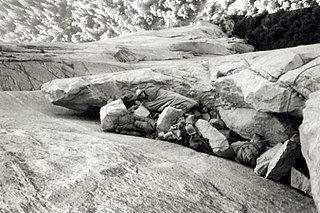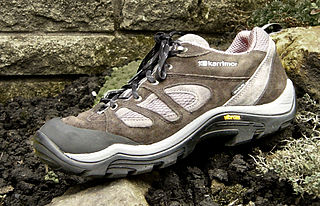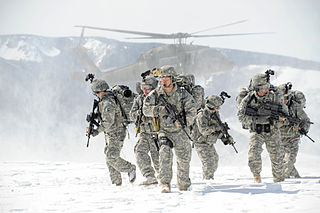External links
- www.gore-tex.com
- Pioneering Seattle Area Companies: Early Winters
- Sahalie
- Picture of Early Winters spire in the North Cascades of Washington
- The Most Influential Gear of All Time, Outside Magazine, May 2012
| Industry | Manufacturing |
|---|---|
| Headquarters | Seattle , United States |
Early Winters, Ltd. of Seattle, Washington, United States was founded in 1972 by William S. Nicolai, who formed the company after creating a tent called the Omnipotent. [1] Early Winters was the first company to create and sell a consumer product made with Gore-Tex laminates produced by W. L. Gore & Associates in Elkton, Maryland. The first product made with Gore-Tex fabric debuted in 1976 and was a streamlined, two-person tent called The Light Dimension. [2] The tent was created by Nicolai and William H. Edwards and was marketed by Ron Zimmerman.
In 1975, Gore salesman Joe Tanner introduced Early Winters to the fabric product, which at that time was still without a name. Over a two-year period, Tanner had made numerous sales calls and had been turned down by companies such as REI, Eddie Bauer, and The North Face. Early Winters was the first company to realize the significance of Gore-Tex fabrics for outdoor applications. In fact, the timing of Tanner's visit was fortuitous since Early Winters had a lightweight, single-walled tent design for which they were seeking a waterproof and breathable fabric solution. [3]
When Tanner showed Early Winters the product sample, the Early Winters staff tried it out by using a rubber band to secure a sample of the fabric over a coffee cup filled with boiling water. This allowed visible steam to pass through the Gore-Tex fabric, but when the cup was turned over, no liquid was claimed to come through. [4] This consumer demonstration became known at W.L. Gore & Associates as the "Z Square" test, named after Zimmerman. This "coffee cup" demonstration has become well known in the outdoor industry because it is an effective way to convey the concept of fabric that is waterproof, yet breathable.
After learning about the product, Nicolai, Edwards, and Zimmerman requested sample material for experimentation, and in Winter 1975, they produced a prototype tent that they subjected to testing in extreme outdoor conditions. [5] After success with the prototype tent, Early Winters became the first commercial company to place an order for Gore-Tex fabric. [6] Early Winters introduced The Light Dimension tent in May 1976. [7] This tent, along with other items made with GORE-TEX fabric, debuted in the first official Early Winters catalogue. [8]
Early Winters approached $20 million (USD) in annual sales, mostly through catalogs, before being sold to the Orvis company in 1984. It was later purchased by the Norm Thompson group in Portland, Oregon. In 2004, Norm Thompson renamed the company Sahalie who still sells Early Winters branded clothing.

Gore-Tex is a waterproof, breathable fabric membrane and registered trademark of W. L. Gore & Associates. Invented in 1969, Gore-Tex can repel liquid water while allowing water vapor to pass through and is designed to be a lightweight, waterproof fabric for all-weather use. It is composed of stretched polytetrafluoroethylene (PTFE), which is more commonly known by the generic trademark Teflon. The material is formally known as the generic term expanded PTFE (ePTFE).
Wilbert Lee "Bill" Gore was an American businessman and entrepreneur who co-founded W. L. Gore and Associates with his wife, Genevieve (Vieve).
Berghaus Limited is a British outdoor clothing and equipment brand founded in Newcastle upon Tyne, North East England, and now headquartered in nearby Sunderland. It was founded in 1966 by climbers and mountaineers Peter Lockey and Gordon Davison, initially as an importer and distributor of outdoors products. Lockey and Davison's outdoor store in Newcastle upon Tyne, went by the name of the LD Mountain Centre. In 1972 they began designing and manufacturing their own products for sale in their shop. They gave their brand the German name 'Berghaus' which translates as 'mountain house'.

A bivouac shelter is any of a variety of improvised camp site, or shelter that is usually of a temporary nature, used especially by soldiers, or persons engaged in backpacking, bikepacking, scouting, or mountain climbing. It may often refer to sleeping in the open with a bivouac sack, but it may also refer to a shelter constructed of natural materials like a structure of branches to form a frame, which is then covered with leaves, ferns, and similar material for waterproofing and duff for insulation. Modern bivouacs often involve the use of one or two man tents but may also be without tents or full cover. In modern mountaineering the nature of the bivouac shelter will depend on the level of preparedness; in particular whether existing camping and outdoor gear may be incorporated into the shelter. A bivouac shelter is colloquially known as a bivvy.

Waterproof fabrics are fabrics that are, inherently, or have been treated to become, resistant to penetration by water and wetting. The term "waterproof" refers to conformance to a governing specification and specific conditions of a laboratory test method. They are usually natural or synthetic fabrics that are laminated to or coated with a waterproofing material such as rubber, polyvinyl chloride (PVC), polyurethane (PU), silicone elastomer, fluoropolymers, and wax. Treatment could be either of the fabric during manufacture or of completed products after manufacture, for instance by a waterproofing spray. Examples include the rubberized fabric used in Mackintosh jackets, sauna suits and inflatable boats.

Durable water repellent, or DWR, is a coating added to fabrics at the factory to make them water-resistant (hydrophobic). Most factory-applied treatments are fluoropolymer based; these applications are quite thin and not always effective. Durable water repellents are commonly used in conjunction with waterproof breathable fabrics such as Gore-Tex to prevent the outer layer of fabric from becoming saturated with water. This saturation, called 'wetting out,' can reduce the garment's breathability and let water through. As the DWR wears off over time, re-treatment is recommended when necessary. Many spray-on and wash-in products for treatment of non-waterproof garments and re-treatment of proofed garments losing their water-repellency are available.
Windstopper is a windproof breathable fabric laminate made by W. L. Gore & Associates. One of its most common applications is a lamination with polar fleece, to compensate for fleece's lack of wind resistance.

Arc'teryx is a design company that sells outdoor clothing and climbing gear. The headquarters and design centre are located in North Vancouver, with a local manufacturing facility called "ARC’One", located in New Westminster. There are overseas teams located in Munich, Shanghai and Tokyo. The company is currently a subsidiary of Chinese sportwear company Anta.

W. L. Gore & Associates, Inc. is an American multinational manufacturing company specializing in products derived from fluoropolymers. It is a privately held corporation headquartered in Newark, Delaware. It is best known as the developer of waterproof, breathable Gore-Tex fabrics.
Dubarry of Ireland is an Irish-owned company with a collection of premium performance footwear, clothing, leather goods and accessories. Established in 1937, Dubarry markets a range of sailing and country footwear and clothing for both women and men. This includes waterproof, Gore-Tex-lined performance sailing boots and leather deck shoes. In addition to its range of country lifestyle boots, Dubarry also has an extensive range of outerwear, knits and shirting in a wide variety of materials from tweed to Alpaca wool. The headquarters of the company is at Ballinasloe, County Galway, Ireland. Over the years Dubarry has expanded its international sourcing network and now works closely with a select group of specialised production partners worldwide.

Fjällräven is a Swedish company specialising in outdoor equipment—mostly upscale clothing and backpacks. It was founded in 1960 by Åke Nordin (1936–2013). The company went public in 1983 with an over-the-counter listing in Stockholm.

Karrimor is a British brand of backpacks, outdoor and sports equipment, and clothing.
Marmot is an outdoor recreation clothing and sporting goods company founded in 1974 as "Marmot Mountain Works". The company was founded in Grand Junction, Colorado by local resident Tom Boyce and two University of California, Santa Cruz students, David Huntley and Eric Reynolds, who shared the common goal of making their own mountaineering equipment. Two years prior to the founding of Marmot, Boyce secured an order for the climbing apparel used in the film The Eiger Sanction starring Clint Eastwood, and Huntley made the original prototype gear that Boyce was using on the Wolper Productions/ National Geographic documentary Journey to the Outer Limits, about the Colorado Outward Bound School. It was during this documentary production that cameraman Mike Hoover, who later worked on Eiger Sanction, saw the equipment that Boyce was using during the portion filmed in Peru. Just prior to Christmas 1973, Mike Hoover called Boyce and placed the order that led to the formation of the company in Grand Junction.

The Extended Cold Weather Clothing System is a protective clothing system developed in the 1980s by the United States Army Natick Soldier Research, Development and Engineering Center, Natick, Massachusetts. The first generation ECWCS consisted of parka and trousers plus 20 other individual clothing, handwear, headwear and footwear items which are used in various combinations to meet the cold weather environmental requirements of the US military. The Gen III ECWCS is designed to maintain adequate environmental protection in temperatures ranging between -60 and +40 Fahrenheit
Craghoppers is a British outdoor clothing manufacturer and supplier that was founded in Batley, West Yorkshire in 1965. It is best known for its walking gear Kiwi range.
Ventile, is a registered trademark used to brand a special high-quality woven cotton fabric first developed by scientists at the Shirley Institute in Manchester, England. Originally created to overcome a shortage of flax used for fire hoses and water buckets, its properties were also found to be ideal for pilots' immersion suits.

Robert W. Gore was an American engineer and scientist, inventor and businessman. Gore led his family's company, W. L. Gore & Associates, in developing applications of polytetrafluoroethylene (PTFE) ranging from computer cables to medical equipment to the outer layer of space suits. His most significant breakthrough was likely the invention of Gore-Tex, a waterproof and breathable fabric popularly known for its use in sporting and outdoor gear.

Mountain Hardwear is a subsidiary of Columbia Sportswear based in Richmond, California that manufactures and distributes apparel, accessories and equipment primarily for the high performance needs of mountaineering enthusiasts and outdoor athletes, as well as for consumers who are inspired by the outdoor lifestyle.

Waxed cotton is cotton impregnated with a paraffin or natural beeswax based wax, woven into or applied to the cloth. Popular from the 1920s to the mid-1950s, the product, which developed from the sailing industry in England and Scotland, became commonly used for waterproofing. It has been replaced by more modern materials but is still used by the country sports community. The main drawbacks are two: waxed fabric is not very breathable and tends to be heavier and bulkier than modern synthetic waterproof materials.
Hipora is a waterproof and breathable fabric, used as insert in winter, motorcycle and cycling gloves. It is developed by the Korean company Kolon Industries.